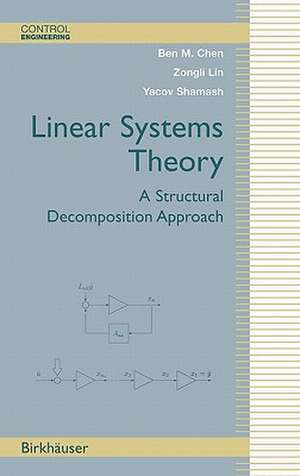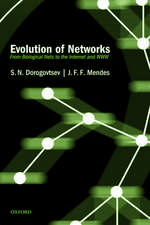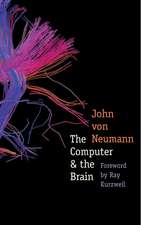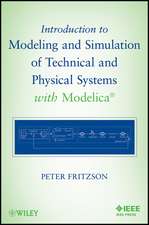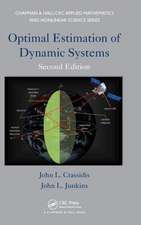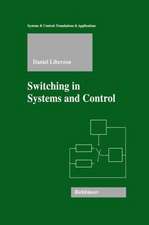Linear Systems Theory: A Structural Decomposition Approach: Control Engineering
Autor Ben M. Chen, Zongli Lin, Yacov Shamashen Limba Engleză Hardback – 27 aug 2004
| Toate formatele și edițiile | Preț | Express |
|---|---|---|
| Paperback (1) | 396.24 lei 43-57 zile | |
| Birkhäuser Boston – 16 sep 2011 | 396.24 lei 43-57 zile | |
| Hardback (1) | 538.76 lei 43-57 zile | |
| Birkhäuser Boston – 27 aug 2004 | 538.76 lei 43-57 zile |
Din seria Control Engineering
- 18%
 Preț: 769.02 lei
Preț: 769.02 lei - 18%
 Preț: 822.82 lei
Preț: 822.82 lei - 18%
 Preț: 891.06 lei
Preț: 891.06 lei - 20%
 Preț: 800.64 lei
Preț: 800.64 lei - 18%
 Preț: 978.69 lei
Preț: 978.69 lei - 15%
 Preț: 702.54 lei
Preț: 702.54 lei - 18%
 Preț: 947.85 lei
Preț: 947.85 lei - 18%
 Preț: 730.02 lei
Preț: 730.02 lei - 18%
 Preț: 945.30 lei
Preț: 945.30 lei - 15%
 Preț: 648.24 lei
Preț: 648.24 lei - 15%
 Preț: 652.64 lei
Preț: 652.64 lei - 15%
 Preț: 641.35 lei
Preț: 641.35 lei - 15%
 Preț: 650.86 lei
Preț: 650.86 lei - 15%
 Preț: 652.49 lei
Preț: 652.49 lei - 15%
 Preț: 647.27 lei
Preț: 647.27 lei -
 Preț: 380.84 lei
Preț: 380.84 lei - 15%
 Preț: 707.78 lei
Preț: 707.78 lei - 18%
 Preț: 1113.89 lei
Preț: 1113.89 lei - 18%
 Preț: 1683.66 lei
Preț: 1683.66 lei -
 Preț: 400.65 lei
Preț: 400.65 lei - 15%
 Preț: 650.86 lei
Preț: 650.86 lei - 18%
 Preț: 952.72 lei
Preț: 952.72 lei - 15%
 Preț: 704.87 lei
Preț: 704.87 lei - 18%
 Preț: 950.96 lei
Preț: 950.96 lei - 18%
 Preț: 1025.16 lei
Preț: 1025.16 lei - 15%
 Preț: 646.11 lei
Preț: 646.11 lei - 18%
 Preț: 960.78 lei
Preț: 960.78 lei - 15%
 Preț: 580.17 lei
Preț: 580.17 lei - 15%
 Preț: 643.34 lei
Preț: 643.34 lei -
 Preț: 394.12 lei
Preț: 394.12 lei - 20%
 Preț: 654.55 lei
Preț: 654.55 lei - 19%
 Preț: 569.56 lei
Preț: 569.56 lei - 18%
 Preț: 952.40 lei
Preț: 952.40 lei
Preț: 538.76 lei
Preț vechi: 633.83 lei
-15% Nou
Puncte Express: 808
Preț estimativ în valută:
103.12€ • 112.05$ • 86.68£
103.12€ • 112.05$ • 86.68£
Carte tipărită la comandă
Livrare economică 21 aprilie-05 mai
Preluare comenzi: 021 569.72.76
Specificații
ISBN-13: 9780817637798
ISBN-10: 0817637796
Pagini: 416
Ilustrații: XVI, 416 p.
Dimensiuni: 155 x 235 x 25 mm
Greutate: 0.73 kg
Ediția:2004
Editura: Birkhäuser Boston
Colecția Birkhäuser
Seria Control Engineering
Locul publicării:Boston, MA, United States
ISBN-10: 0817637796
Pagini: 416
Ilustrații: XVI, 416 p.
Dimensiuni: 155 x 235 x 25 mm
Greutate: 0.73 kg
Ediția:2004
Editura: Birkhäuser Boston
Colecția Birkhäuser
Seria Control Engineering
Locul publicării:Boston, MA, United States
Public țintă
ResearchCuprins
1 Introduction and Preview.- 1.1 Motivation.- 1.2 Preview of Each Chapter.- 1.3 Notation.- 2 Mathematical Background.- 2.1 Introduction.- 2.2 Vector Spaces and Subspaces.- 2.3 Matrix Algebra and Properties.- 2.4 Norms.- 3 Review of Linear Systems Theory.- 3.1 Introduction.- 3.2 Dynamical Responses.- 3.3 System Stability.- 3.4 Controllability and Observability.- 3.5 System Invertibilities.- 3.6 Normal Rank, Finite Zeros and Infinite Zeros.- 3.7 Geometric Subspaces.- 3.8 Properties of State Feedback and Output Injection.- 3.9 Exercises.- 4 Decompositions of Unforced and/or Unsensed Systems.- 4.1 Introduction.- 4.2 Autonomous Systems.- 4.3 Unforced Systems.- 4.4 Unsensed Systems.- 4.5 Exercises.- 5 Decompositions of Proper Systems.- 5.1 Introduction.- 5.2 SISO Systems.- 5.3 Strictly Proper Systems.- 5.4 Nonstrictly Proper Systems.- 5.5 Proofs of Properties of Structural Decomposition.- 5.6 Kronecker and Smith Forms of the System Matrix.- 5.7 Discrete-time Systems.- 5.8 Exercises.- 6 Decompositions of Descriptor Systems.- 6.1 Introduction.- 6.2 SISO Descriptor Systems.- 6.3 MEMO Descriptor Systems.- 6.4 Proofs of Theorem 6.3.1 and Its Properties.- 6.5 Discrete-time Descriptor Systems.- 6.6 Exercises.- 7 Structural Mappings of Bilinear Transformations.- 7.1 Introduction.- 7.2 Mapping of Continuous- to Discrete-time Systems.- 7.3 Mapping of Discrete- to Continuous-time Systems.- 7.4 Proof of Theorem 7.2.1.- 7.5 Exercises.- 8 System Factorizations.- 8.1 Introduction.- 8.2 Strictly Proper Systems.- 8.3 Nonstrictly Proper Systems.- 8.4 Discrete-time Systems.- 8.5 Exercises.- 9 Structural Assignment via Sensor/Actuator Selection.- 9.1 Introduction.- 9.2 Simultaneous Finite and Infinite Zero Placement.- 9.3 Complete Structural Assignment.- 9.4 Exercises.- 10 Time-Scale and Eigenstructure Assignment via State Feedback.- 10.1 Introduction.- 10.2 Continuous-time Systems.- 10.3 Discrete-time Systems.- 10.4 Exercises.- 11 Disturbance Decoupling with Static Output Feedback.- 11.1 Introduction.- 11.2 Left Invertible Systems.- 11.3 General Multivariable Systems.- 11.4 Exercises.- 12 A Software Toolkit.- 12.1 Introduction.- 12.2 Descriptions of m-Functions.
Textul de pe ultima copertă
This text is the first comprehensive treatment of structural decompositions of various types of linear systems, including autonomous, unforced or unsensed, strictly proper, non-strictly proper, and descriptor or singular systems. Structural properties play an important role in the understanding of linear systems and also provide insight to facilitate the solution of control problems related to stabilization, disturbance decoupling, robust and optimal control. Applications can be extended to industrial process control, aircraft and ship control, process automation control, and many other types of engineering systems.
The authors employ a unique structural decomposition approach to break down an overall system into various subsystems, each with distinct features. The simplicity of these subsystems and their interconnections lead to deep insight about the design of feedback control systems for desired closed-loop performance, stability, and robustness. All results and case studies are presented in both continuous- and discrete-time settings. Exercises, as well as MATLAB-based computational and design algorithms utilizing the Linear Systems Toolkit, are included to reinforce and demonstrate the concepts treated throughout the book.
Topics covered include:
* Basic Concepts of Linear Systems Theory
* Decomposition of Unforced and/or Unsensed Systems, Proper Systems and their Properties
* Decomposition of Descriptor Systems and their Properties
* Cascade and Inner-Outer Factorizations
* Structural Assignment through Sensor/Actuator Selections
* State Feedback Control with Time-Scale and Eigenstructure Assignment
* Disturbance Decoupling with Static Output Feedback
Linear Systems Theory may be used as a textbook for advanced undergraduate and graduate students in aeronautics and astronautics, applied mathematics, chemical, electrical and mechanical engineering. It may also serve as a valuable self-study reference for researchers and engineering practitioners in areas related to systems and control theory.
The authors employ a unique structural decomposition approach to break down an overall system into various subsystems, each with distinct features. The simplicity of these subsystems and their interconnections lead to deep insight about the design of feedback control systems for desired closed-loop performance, stability, and robustness. All results and case studies are presented in both continuous- and discrete-time settings. Exercises, as well as MATLAB-based computational and design algorithms utilizing the Linear Systems Toolkit, are included to reinforce and demonstrate the concepts treated throughout the book.
Topics covered include:
* Basic Concepts of Linear Systems Theory
* Decomposition of Unforced and/or Unsensed Systems, Proper Systems and their Properties
* Decomposition of Descriptor Systems and their Properties
* Cascade and Inner-Outer Factorizations
* Structural Assignment through Sensor/Actuator Selections
* State Feedback Control with Time-Scale and Eigenstructure Assignment
* Disturbance Decoupling with Static Output Feedback
Linear Systems Theory may be used as a textbook for advanced undergraduate and graduate students in aeronautics and astronautics, applied mathematics, chemical, electrical and mechanical engineering. It may also serve as a valuable self-study reference for researchers and engineering practitioners in areas related to systems and control theory.
Caracteristici
First comprehensive book to take a structural decomposition approach to linear systems theory Includes MATLAB-based computational and design algorithms utilizing the "Linear Systems and Control Toolbox" Features new results, examples, and case studies Applications to industry: process control, aircraft and ship control, automotive control
